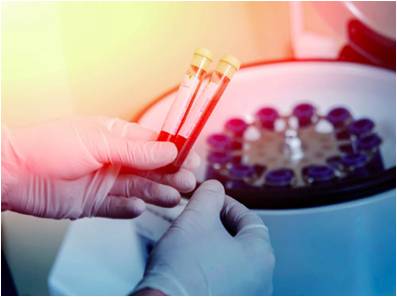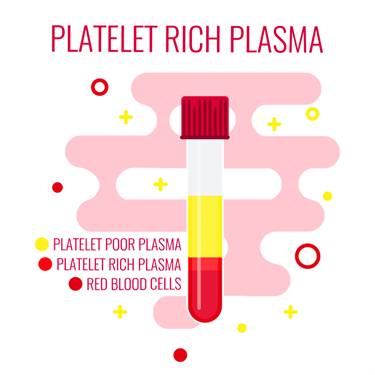
Chiropractor Chandler AZ
Platelet-Rich Plasma Prolotherapy and Lower Back Pain

Platelet-Rich Plasma (PRP) is a blood plasma with an increased amount of platelets as compared to normal blood plasma. PRP was first used in 1987 as a therapeutic modality in an open heart surgery. Today, it is popularly used for the management of pain and other chronic ailments. The use of PRP as a treatment is also on the rise in various medical branches such as sports medicine, dentistry, and cosmetic surgery.
PRP hit the headlines when famous celebrities like Tiger Woods, Angelina Jolie, and Alex Rodriguez underwent a PRP for soft tissue injuries. Results were encouraging: quick heal healing and early return to the activity made PRP a preferred treatment. Since then, the popularity of the treatment is on the rise amongst common people.
Platelet-Rich PlasmaOur blood contains plasma, platelets, and blood cells – red and white. The platelets contain many proteins out of which one protein (the growth factor) plays an important role in healing. Therefore, PRP is a type of plasma with 5 to 10 times higher platelet counts than the normal blood plasma.
How PRP Therapy WorksHow the PRP therapy works is still a matter of debate and ongoing research. Though preliminary, the research and results on this aspect of tissue healing have been quite positive and back the use of PRP therapy as a novel approach for treating chronic ailments.
When you suffer an injury or a trauma, platelets are the first cells to reach the injury site. Platelets secrete a multitude of chemicals including chemokines, cytokines, and a variety of growth factors. These chemicals limit the injury and promote the 'programmed-death' of damaged and worn-out cells. In addition, the chemicals from platelets promote the growth of new cells and improve the growth of blood vessels. These factors add up and lead to a swift recovery and better healing outcomes.
The mechanisms mentioned above are the proven natural functions of platelets in the event of an injury or a trauma. So it seems logical that the injection of platelet-rich plasma into or around the injury site would promote healing and recovery.
PRP PreparationPRP is made from the patient's own blood sample. During the treatment, the doctor or the lab technician first draws blood from the patient. An anticoagulant (commonly citrate dextrose) is used to prevent the clotting of the blood, which can hinder the procedure. Centrifugation, a process of raising the concentration of the extracted plasma, is used to separate the platelet-rich plasma from the platelet-poor plasma. The final PRP yield is 10% to 15% of the blood sample of the patient.
Methods of PRP preparationAll methods of PRP preparation work on the principle of differential centrifugation. Currently, the following two methods are most commonly used:
- PRP method
- Buffy-coat method
In the PRP method, the initial centrifugation is followed by a second centrifugation. The first centrifugation separates the platelets from the blood cells and the second centrifugation increases the number of platelets.

During the first centrifugation, the whole blood (WB) breaks up into the following 3 layers:
- Layer 1: made of platelets and white blood cells (WBCs)
- Layer 2: made of WBCs (Buffy coat layer)
- Layer 3: made of RBCs
The first two layers are separated carefully and moved into a sterile tube. A careful separation of the first two layers is very important to exclude the RBCs and obtain a pure PRP (P-PRP).
Following the above separation, the second centrifugation is completed at a high speed. This results in the formation of PRP in the lower one-third of the tube and Platelets-poor plasma (PPP) in the upper two- thirds of the tube.
In the Buffy coat method, blood is stored at a temperature of 20°C to 24°C prior to centrifugation. The high-speed centrifugation of pre-cooled whole blood gives three layers:
- The upper layer containing platelet-poor plasma
- The middle layer containing platelets and WBCs
- The lower layer containing the RBCs
The layer of PPP is separated from the top, and the buffy coat is passed into another tube. This buffy coat is then filtered through leukocyte filtration filter to separate WBCs from plasma.
Classification of PRPPRP can be classified into the following 4 classes depending on the cell content and architecture of fibrin:
- Pure Platelet-Rich Plasma (P-PRP)
- Leucocyte and –PRP (L-PRP)
- Pure-Platelet Rich Fibrin (P-PRF)
- Leucocyte and Platelet- rich fibrin(L-PRF)
PRP injections are administered into the painful tissues or joints. The injection is given under ultrasound or fluoroscopic guidance to make sure that the protein is injected to the correct site.

PRP can always be used as a substitute for surgery whenever possible, especially in musculoskeletal conditions or injuries.
Many recent studies have shown that PRP plays an important role in healing or managing musculoskeletal injuries. According to the World Health Organization (WHO), injuries to the musculoskeletal system, in particular during sports, are the most common cause of pain and disability, and ones that need early treatment.
PRP has proven to be very effective in managing injuries of the bones, tendons, ligaments, muscles, cartilages, and menisci. It has also been used to treat various other conditions including repair of the shoulder cuff and Achilles' tendon. Doctors have noticed potential results of PRP in the spine, in particular back pain, when all the other possible treatments have failed.
Back pain is a common musculoskeletal condition. It mostly affects people between the age group of 30 to 55 years. More than 80% of people suffer from back pain at one point in their life. Back pain can be a consequence of injuries to the bones, muscles, or tendons of the spine.
Common causes of back pain can be trauma such as a fall or accident, any previous surgery of the back, a disease directly or indirectly affecting the back, or lifting heavy weights. In addition, back pain can be idiopathic, that is, when the cause is not known. Of all the pains in the back, pain in the lower spine (sacroiliac joint) is the most common.
Back pain may be accompanied by muscle spasms and numbness and tingling sensations depending on the cause of the pain. Lower back pain mostly radiates to the buttocks or legs due to compression of the nerves at the spinal level.
The doctor confirms the presence of back pain by performing a physical examination and imaging tests, such as CT scan, MRI, x-rays, and other tests depending on the presentation of the pain.
Treatment of PRP may vary according to the diagnosis. PRP can be considered as the first choice because of its early healing capacity. A study done showed that PRP can increase the diameter of the sacroiliac (SI) ligament in 3 months from the time of treatment.
The injection is given near the site of injury under fluoroscopy or ultrasound guidance. The procedure is painless. If pain arises, the patient is given over the counter Tylenol. The injection therapy does not have any side effect because the patient's own blood is being used.
Once injected, the platelet-rich plasma deposits platelets at the site of injury. The growth factor in the platelets intensifies the normal process of tissue healing by increasing the production of new collagen. This new collagen settles in the damaged soft tissues making them strong and elastic. This may cause an increase in pain for a few weeks before the patient starts feeling relieved.
The number of injections given depends on the patient's condition – how well the patient can tolerate the injections. Around three injections are given in 6 months. A study performed in patients with severe back pain showed that the group of patients who received PRP for about 8 weeks had a marked relief in pain than the other group, which did not receive the injection.
In another research, Merriman et al. used prolotherapy (PRP therapy) for the treatment of patients with low back pain due to sciatica. He concluded that PRP therapy is superior to the conservative treatment methods as the treatment was able to achieve desirable positive outcomes in 80-90 patients. Moreover, PRP had a better safety profile compared to conventional methods.
Treating back pain by PRP injections does not have any complications. However, in rare cases, there can be a risk of infections, nerve damage, or bleeding. Contact your doctor if you are not sure about any complications arising.
The healing process after the injection is slow, therefore, the patient needs to wait for complete healing before resuming daily activities.
Patients with any blood-related disorder should not be given PRP therapy as it may cause complications. Contact your doctor before perusing PRP injections for back pain relief.
Conservative Therapy & PRPPRP is commonly performed in conjunction with conservative therapy treatments, such as chiropractic, physical therapy, massage, therapy, Graston Technique, spinal decompression, and cold laser therapy.
Chiropractic adjustments types include flexion distraction, manual manipulation, Activator Technique, and Thompson Drop Technique. Goals of physical therapy are to increase low back strength and endurance of back and core muscles. Specific stabilization and neuromuscular education exercise will help to reduce joint pain and future risks of injuries and sprains. Specific stretches enhance the exercise and eliminate excessive strain on low back joints.
Massage therapy, manual therapy, Active release technique, and Graston Technique help the muscles heal and eliminate soft tissue pain. Muscles can become injured with chronic low back injuries, and soft tissue treatments help restore muscle function and function.
References:
- Ahmad Z, Howard D, Brooks RA, et al. The role of platelet-rich plasma in musculoskeletal science. JRSM Short Rep. 2012;3(6):40. www.ncbi.nlm.nih.gov/pmc/articles/PMC3386662/. Accessed October 01, 2016.
- Duhrat R, Sukesh MS. Principles and methods of platelet-rich plasma: A review and author's perspective. J Cutan Aesthet Surg. 2014;7(4):189-197. https://www.ncbi.nlm.nih.gov/pmc/articles/PMC4338460/
- Fukaya, Mototsugu MD; Ito, Asako MD. A New Economic Method for Preparing Platelet-rich Plasma. Plastic and Reconstructive Surgery- Global Open. 2014;2(6):p e162. journals.lww.com/prsgo/Fulltext/2014/06000/A_New_Economic_Method_for_Preparing_Platelet_rich.7.aspx.
- Sampson S, Gerhardt M, Mandelbaum B. Platelet-rich plasma injection grafts for musculoskeletal injuries: a review. Curr Rev Musculoskelet Med. 2008;1(3-4):165-174. www.ncbi.nlm.nih.gov/pmc/articles/PMC2682411/.
- http://orthoinfo.aaos.org/topic.cfm?topic=A00648
- Meinrad Gawaz, Sebastian Vogel. Platelets in tissue repair: control of apoptosis and interactions with regenerative cells. Blood 2013 122:2550-2554. http://www.bloodjournal.org/content/122/15/2550.long?sso-checked=true
- MERRIMAN JR. PROLOTHERAPY VERSUS OPERATIVE FUSION IN THE TREATMENT OF JOINT INSTABILITY OF THE SPINE AND PELVIS. J Int Coll Surg. 1964 Aug;42:150-9.